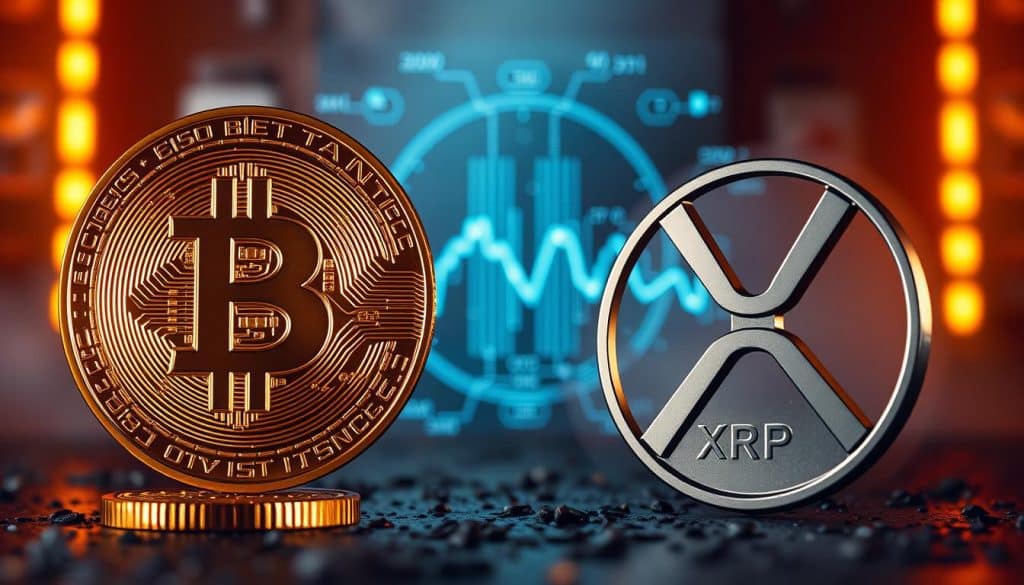Bitcoin and XRP represent over $500 billion in total market capitalization. These digital giants have fascinating distinctions that could reshape your investment strategy. Let’s explore their key differences by comparing Bitcoin and XRP.
At first glance, Bitcoin and XRP may seem similar. However, comparing Bitcoin and XRP reveals that they’re fundamentally different approaches to digital finance. Their unique technologies and purposes set them apart in the cryptocurrency landscape.
Bitcoin is a decentralized digital currency designed as an alternative to traditional money systems. XRP, developed by Ripple, focuses on enabling faster and cheaper international financial transactions.
By comparing Bitcoin and XRP, investors can understand how each fits into the evolving digital economy. Knowing their unique features and use cases helps in making informed and strategic investment decisions.
Key Takeaways
- Bitcoin and XRP serve different primary purposes in the cryptocurrency ecosystem
- Technological frameworks of both cryptocurrencies differ significantly
- Market performance varies dramatically between Bitcoin and XRP
- Regulatory environments impact each cryptocurrency uniquely
- Investment strategies should consider distinct characteristics of each digital asset
Introduction to Bitcoin and XRP
Digital currencies have transformed financial landscapes. Bitcoin and XRP are two revolutionary blockchain-based technologies. These cryptocurrencies differ in their origins, design philosophies, and technological foundations.
Overview of Bitcoin: The Original Cryptocurrency
Bitcoin emerged in 2009, created by the mysterious Satoshi Nakamoto. It introduced a decentralized financial system and peer-to-peer transaction network.
Bitcoin has a limited supply of 21 million coins. It uses a proof-of-work consensus mechanism for security and validation.
- Decentralized financial system
- Peer-to-peer transaction network
- Limited supply of 21 million coins
- Proof-of-work consensus mechanism
“Bitcoin represents a fundamental transformation in how we perceive money and financial transactions.” – Digital Currency Expert
Overview of XRP: The Banking-Focused Cryptocurrency
XRP, developed by Ripple Labs in 2012, took a different approach. It focused on streamlining international financial transactions.
Unlike Bitcoin, XRP uses a centralized validation system. This allows for lower transaction costs and faster processing times.
- Designed for rapid cross-border payments
- Centralized validation system
- Lower transaction costs
- Faster processing times
Historical Context of Cryptocurrency Evolution
The digital currency landscape shows rapid technological growth. Bitcoin emerged as a revolutionary decentralized concept. XRP positioned itself within traditional banking infrastructures.
These digital currencies represent different approaches to reimagining financial technologies. They demonstrate blockchain’s potential to disrupt traditional financial systems.
Bitcoin and XRP each have unique strengths and philosophical foundations. They continue to shape the future of digital finance.
Comparing Bitcoin and XRP: Key Differences Explained
Here’s a clear and concise comparison table showing the key differences between Bitcoin and XRP
| Feature | Bitcoin (BTC) | XRP (Ripple) |
|---|---|---|
| Launch Year | 2009 | 2012 |
| Creator | Satoshi Nakamoto | Ripple Labs (Chris Larsen & Jed McCaleb) |
| Purpose | Decentralized digital currency for peer-to-peer payments | Fast, low-cost international payments for financial institutions |
| Consensus Mechanism | Proof of Work (PoW) | Ripple Protocol Consensus Algorithm (RPCA) |
| Transaction Speed | ~10 minutes per transaction | 3–5 seconds |
| Transaction Cost | Around $1–$5 (varies with network load) | Less than $0.01 |
| Network Energy Use | High (energy-intensive mining) | Very low (no mining required) |
| Supply Limit | 21 million BTC | 100 billion XRP (pre-mined) |
| Decentralization Level | Fully decentralized | More centralized, managed by Ripple Labs |
| Use Case | Store of value, digital gold | Cross-border payments, liquidity bridge for banks |
| Adoption | Widely accepted by merchants, investors, and institutions | Growing adoption by banks and payment providers |
| Regulatory Status (2025) | Generally accepted as a commodity | Recently cleared of major SEC issues, improving market confidence |
When comparing Bitcoin and XRP, Bitcoin stands out as the pioneer of decentralized digital money, while XRP focuses on transforming global payments. Each serves different purposes — Bitcoin as “digital gold,” XRP as a “banking bridge.”
Technology Behind Bitcoin and XRP
Bitcoin and XRP showcase distinct approaches to digital financial infrastructure. They differ in their use of blockchain and distributed ledger systems. These differences shape their roles in the cryptocurrency landscape.
Blockchain vs. Ledger Technology
Bitcoin and XRP use different core technological frameworks. Bitcoin relies on traditional blockchain technology. XRP uses a unique consensus protocol, setting it apart from blockchain.
- Transactions are verified through mining
- Each block contains a cryptographic hash of the previous block
- Decentralization is a key principle
XRP’s distributed ledger technology offers several advantages. It enables faster transaction validation and uses less energy. However, it also allows for more centralized control.
- Faster transaction validation
- Lower energy consumption
- More centralized control
Transaction Processing Times
Speed is a key difference between these cryptocurrencies. Bitcoin transactions typically require 10 minutes or longer for confirmation. XRP, however, can process transactions in just seconds.
Scalability Solutions
Scalability is another crucial technological challenge. Bitcoin faces network congestion issues. XRP, on the other hand, was built to handle large transaction volumes efficiently.
- Bitcoin: Limited block size, slower transaction processing
- XRP: Designed for high-speed, high-volume transactions
The technological evolution of cryptocurrencies continues to push the boundaries of digital financial systems.
Market Performance Comparison
Investors often compare Bitcoin and XRP performance in the crypto market. Understanding these digital assets’ dynamics offers valuable investment insights. This comparison provides a critical perspective for making informed decisions.
Bitcoin and XRP showcase different market behaviors in the crypto ecosystem. Bitcoin holds the top market position. XRP attracts investors with its unique characteristics.
Bitcoin Price Trends
Bitcoin’s price shows remarkable volatility. Here are key observations:
- Significant price fluctuations between $20,000 and $60,000
- Rapid value changes driven by market sentiment
- Strong institutional investment influence
XRP Price Trends
XRP’s market dynamics differ from Bitcoin’s. Its characteristics include:
- More stable price movements
- Lower overall market volatility
- Strong potential in cross-border transaction markets
Market Capitalization Statistics
| Cryptocurrency | Market Cap | Price Range | Investor Interest |
|---|---|---|---|
| Bitcoin | $1.2 trillion | $30,000 – $60,000 | High institutional involvement |
| XRP | $32 billion | $0.40 – $0.80 | Growing financial sector adoption |
Crypto market capitalization reveals more than just numbers. Each cryptocurrency represents unique technological and financial ecosystems. These differences shape their roles in the broader crypto market.
Use Cases and Adoption Rates
Bitcoin and XRP serve different purposes in the crypto world. Their real-world uses highlight key differences. Let’s explore how these digital currencies function in various scenarios.
Bitcoin as Digital Gold
Bitcoin has become a powerful store of value. Many compare it to traditional gold investments. Investors see it as a shield against economic instability.
Bitcoin’s key features include its decentralized nature and limited supply. It offers protection against inflation. More institutions are accepting Bitcoin as a legitimate asset.
XRP in the Financial Sector
XRP stands out for its practical financial uses. It excels in cross-border transactions with impressive speed and efficiency.
XRP’s strengths lie in rapid processing and low transaction costs. It has formed strategic partnerships with financial institutions. XRP aims to improve global payment infrastructure.
Real-World Cryptocurrency Applications
Both cryptocurrencies show growing real-world utility. Bitcoin is gaining ground as a payment method for various businesses.
Meanwhile, XRP is changing how international money transfers work. It offers faster and cheaper alternatives to traditional methods.
The future of digital currencies lies in their practical applications beyond speculative investment.
Understanding these digital currency differences is vital for smart investing. Keep an eye on how Bitcoin and XRP evolve in the coming years.
Regulatory Landscape Impact
Regulations shape the future of cryptocurrencies like Bitcoin and XRP. Both face unique legal challenges that affect their market potential. These hurdles also impact investor confidence in digital assets.
Navigating complex legal landscapes has become a major challenge for Bitcoin and XRP. Their regulatory situations differ greatly. This impacts how investors view each cryptocurrency.
Bitcoin’s Regulatory Status
Bitcoin’s regulatory journey has been more stable than XRP’s. Many countries now see Bitcoin as a digital asset or commodity. This gives investors some clarity about its status.
The cryptocurrency comparison shows key regulatory differences. Bitcoin is recognized as property in most major economies. Its taxation frameworks are becoming clearer. Financial regulators are also more accepting of Bitcoin.
- Recognized as property in most major economies
- Taxation frameworks becoming more defined
- Increasing acceptance from financial regulators
“Bitcoin has carved out a more predictable regulatory path compared to other cryptocurrencies.” – Financial Regulatory Expert
XRP’s Legal Challenges
XRP’s regulatory standing is very different from Bitcoin’s. Ripple, the company behind XRP, is in a legal battle with the SEC. The main issue is whether XRP should be classified as a security.
Key Legal Challenges
Bitcoin and XRP face significant regulatory scrutiny. Each has unique legal challenges that could affect their future. These include ongoing SEC litigation for XRP and global regulatory uncertainty.
- Ongoing SEC litigation for XRP
- Global regulatory uncertainty
- Potential classification changes
The cryptocurrency comparison between Bitcoin and Ripple highlights the critical importance of regulatory compliance in the digital asset ecosystem. Investors should stay informed about changing laws. This knowledge helps them make smart investment choices in cryptocurrencies.
Community and Developer Support
Bitcoin and XRP’s success relies on their developer communities. These digital ecosystems thrive on passionate individuals who improve the blockchain technology. Different approaches attract unique perspectives to each project’s growth.
Blockchain communities showcase decentralized and centralized cryptocurrency approaches. They draw diverse developers and enthusiasts. These contributors bring unique insights to each project.
Bitcoin’s Developer Community: A Decentralized Powerhouse
Bitcoin’s developer community truly embodies decentralization. It features open-source collaboration across global networks. The model is volunteer-driven with a diverse international contributor base.
Bitcoin emphasizes consensus-driven improvements. This approach strengthens its distributed developer ecosystem.
- Open-source collaboration across global networks
- Volunteer-driven development model
- Diverse international contributor base
- Emphasis on consensus-driven improvements
“Bitcoin’s strength lies in its distributed developer ecosystem.” – Andreas Antonopoulos
XRP’s Developer Evangelism: A Structured Approach
XRP’s developer community operates with a structured methodology centered around Ripple Labs. They offer targeted grant programs for blockchain developers. Their approach includes structured development roadmaps.
XRP focuses on innovation through XRPL platforms. They also form strategic partnerships with financial institutions.
- Targeted grant programs for blockchain developers
- Structured development roadmaps
- Focused innovation through XRPL platforms
- Strategic partnerships with financial institutions
Community Impact on Project Longevity
The vitality of these cryptocurrency communities influences their long-term sustainability. Engaged developers drive innovation, resolve technical challenges, and maintain the project’s relevance in a rapidly evolving digital landscape.
Both Bitcoin and XRP show the importance of strong developer support. This support is crucial for blockchain technology’s evolution and mainstream adoption.
Security Features: Bitcoin vs. XRP
Cryptocurrency security is crucial in blockchain technology. Investors and experts analyze protective mechanisms for digital assets. Bitcoin and XRP have unique security approaches worth exploring.
Network Security Mechanisms
Bitcoin’s security uses a robust Proof of Work consensus mechanism. Miners solve complex math problems, creating a tough environment for attackers. Each block needs significant computational power, making large-scale attacks costly.
- Bitcoin uses SHA-256 cryptographic hash algorithm
- Decentralized network with thousands of nodes
- No single point of failure in network architecture
Previous Security Incidents
“In the world of cryptocurrencies, security is not a feature—it’s a fundamental promise to users.” – Crypto Security Expert
XRP’s security model is different from Bitcoin’s. Developed by Ripple, XRP uses a unique consensus protocol. It focuses on speed and efficiency.
XRP has faced fewer direct attacks. However, its centralized structure brings different security concerns.
Comparison of Attack Vectors
Bitcoin resists 51% attacks due to its massive distributed network. XRP’s consensus mechanism offers alternative protection strategies.
| Security Feature | Bitcoin | XRP |
|---|---|---|
| Consensus Mechanism | Proof of Work | Unique Consensus Protocol |
| Network Decentralization | Highly Decentralized | Partially Centralized |
| Attack Resistance | Extremely High | Moderate |
Knowing these security approaches helps investors make smart choices. Each platform has its own protective strategies. This reflects the changing world of digital asset security.
Investment Perspectives
Crypto investments demand strategic thinking and careful analysis. Bitcoin and XRP offer different approaches to digital asset investment. They appeal to various investor profiles with their unique characteristics.
Analyzing Bitcoin vs XRP performance is vital for smart investment choices. This comparison helps investors make informed decisions in the crypto market.
Historical Return on Investment for Bitcoin
Bitcoin has shown impressive investment potential since its creation. Its value has grown from pennies to tens of thousands of dollars.
The cryptocurrency has experienced multiple bull runs with significant price increases. Institutional investors now recognize Bitcoin as a store of value.
- Exponential growth from pennies to tens of thousands of dollars
- Multiple bull runs with significant price appreciation
- Recognized as a store of value by institutional investors
XRP Investment Trajectory
XRP’s investment story differs from Bitcoin’s in the crypto world. Its performance has been more subtle and complex.
XRP has formed partnerships with financial institutions. The cryptocurrency shows more stable but less dramatic price movements.
- Partnerships with financial institutions
- More stable but less dramatic price movements
- Potential tied to regulatory developments
Future Investment Predictions
Crypto analysis suggests different potential for both assets:
| Cryptocurrency | Short-Term Outlook | Long-Term Potential |
|---|---|---|
| Bitcoin | High volatility | Potential mainstream adoption |
| XRP | Dependent on legal resolution | Strong financial sector integration |
Investors should approach cryptocurrency investments with caution, understanding that past performance does not guarantee future results.
The key to successful crypto investing is diversification, thorough research, and risk management.
Tools and Resources for Traders
Digital currency trading requires the right tools and platforms. Secure wallets and trading platforms are essential for Bitcoin and XRP investors. These tools provide safety and functionality for crypto investment analysis.
Choosing the right wallet is crucial for managing digital assets safely. Different cryptocurrencies need specific storage solutions. These solutions protect your investments from potential threats.
Bitcoin Wallet Options
- Ledger Nano X (Hardware Wallet)
- Electrum (Desktop Wallet)
- Mycelium (Mobile Wallet)
- Trezor Model T (Hardware Wallet)
XRP Wallet Recommendations
- Xumm Wallet
- Toast Wallet
- Atomic Wallet
- Exodus Wallet
Comparative Trading Platforms
| Platform | Bitcoin Support | XRP Support | User Experience |
|---|---|---|---|
| Coinbase | ✓ | ✓ | Beginner-Friendly |
| Binance | ✓ | ✓ | Advanced Traders |
| Kraken | ✓ | ✓ | Intermediate |
When choosing a crypto investment analysis platform, consider several factors. Look at transaction fees, security features, and supported cryptocurrencies. Do thorough research before committing to any platform.
Security is paramount in crypto trading. Enable two-factor authentication and use hardware wallets for long-term storage. Never share your private keys with anyone.
Understanding digital currency differences is crucial. This knowledge will help you make smart investment choices in the crypto market.
Frequently Asked Questions (FAQs) About Cryptocurrency Investments
Crypto investing can be tricky. Many wonder about bitcoin vs xrp and how cryptocurrencies compare. Let’s explore common questions to help you invest wisely.
Is Bitcoin a Better Investment than XRP?
There’s no simple answer. Bitcoin and XRP serve different roles in the cryptocurrency ecosystem. Bitcoin is a digital store of value. XRP focuses on quick, cheap cross-border transactions.
- Bitcoin: More established, higher market cap
- XRP: Faster transaction times, lower fees
- Investment potential varies based on individual goals
What are the Main Risks of Investing?
Crypto investments have risks. Knowing these can help you make smarter choices in the volatile market.
- Market Volatility: Prices can fluctuate dramatically
- Regulatory Uncertainties
- Security Vulnerabilities
- Technological Challenges
How Can I Buy Bitcoin or XRP?
Buying cryptocurrencies is easier now. Platforms like Coinbase, Binance, and Kraken offer simple ways to invest in bitcoin and XRP.
Pro Tip: Always start with small investments and never risk more than you can afford to lose.
Crypto investing needs ongoing learning and research. Stay updated on market trends, tech advances, and regulations. This helps you make better investment choices.
Conclusion: Making an Informed Choice
Cryptocurrency comparison requires careful analysis and personal insight. Bitcoin and XRP represent distinct approaches to digital financial technologies. Each has unique strengths and potential challenges in the ever-evolving cryptocurrency landscape.
Bitcoin vs Ripple reveals critical differences in technology, market performance, and adoption strategies. Bitcoin is the pioneering decentralized digital currency with significant market presence. XRP focuses on revolutionizing international financial transactions through rapid, cost-effective transfer mechanisms.
Investors must align their choices with specific financial goals and risk tolerances. Successful cryptocurrency investment requires continuous learning and adaptability. No single digital asset represents a universal solution.
Potential investors should study technical documentation and track market trends. Understanding the underlying blockchain technologies driving these innovative financial instruments is crucial. Diversification, thorough research, and a balanced perspective are key to smart investing.
The cryptocurrency world is dynamic and challenges traditional financial paradigms. It offers exciting opportunities for those willing to explore intelligently. Making an informed choice between Bitcoin and XRP demands a nuanced approach.
























 Bitcoin
Bitcoin  Ethereum
Ethereum  Tether
Tether  XRP
XRP  USDC
USDC  TRON
TRON  Lido Staked Ether
Lido Staked Ether  Dogecoin
Dogecoin  Figure Heloc
Figure Heloc  Cardano
Cardano  Bitcoin Cash
Bitcoin Cash  Wrapped stETH
Wrapped stETH  WhiteBIT Coin
WhiteBIT Coin  Wrapped Bitcoin
Wrapped Bitcoin  USDS
USDS  Wrapped eETH
Wrapped eETH  Chainlink
Chainlink  Binance Bridged USDT (BNB Smart Chain)
Binance Bridged USDT (BNB Smart Chain)  LEO Token
LEO Token  WETH
WETH  Monero
Monero  Zcash
Zcash  Stellar
Stellar  Sui
Sui  Coinbase Wrapped BTC
Coinbase Wrapped BTC  Hyperliquid
Hyperliquid  Ethena USDe
Ethena USDe  Litecoin
Litecoin  Avalanche
Avalanche  Hedera
Hedera  Shiba Inu
Shiba Inu  Canton
Canton  sUSDS
sUSDS  World Liberty Financial
World Liberty Financial  USDT0
USDT0  Toncoin
Toncoin  Dai
Dai  Cronos
Cronos  PayPal USD
PayPal USD  Uniswap
Uniswap  Ethena Staked USDe
Ethena Staked USDe  Polkadot
Polkadot  USD1
USD1  Mantle
Mantle  Rain
Rain  MemeCore
MemeCore  Pepe
Pepe  Bittensor
Bittensor